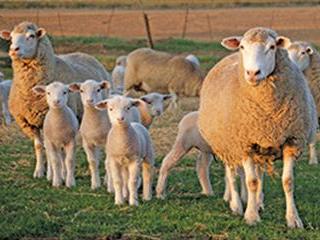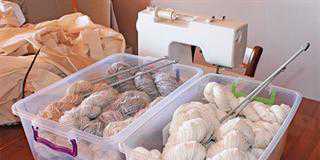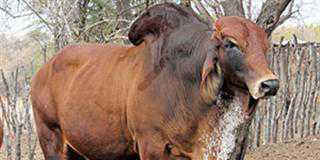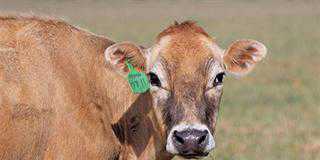
Erika Hanekom’s home reflects all she holds dear in life. There are photos of her late husband Pieter, her three children and six grandchildren in a variety of frames throughout the house. On one of the walls hangs a large picture of a prize-winning Dormer and there are photos and paintings of wildlife everywhere you turn.
A hand-reared chick scurries around the kitchen as Erika warms up a chicken pie she baked the day before. She won’t let you leave without a jar of home-made apricot jam and a few stories of her many trips to the Kgalagadi Transfrontier Park.
But few things get Erika as stirred up as the topic of breeding Dormers for which she has shown a passion and a proficiency.
Award winning breeder
Erika, who was SA Studbook’s Small Livestock Stud Breeder of the Year in 2012, comes from farming stock and has had a love for farming, animals and conservation from an early age. She was born and grew up on a grape farm in the Malmesbury district, close to Renosterbosrug where she has farmed Dormers since her marriage to Pieter Hanekom.

Erika Hanekom and her son Alwyn, farm dairy, Dormer sheep and grapes on the farm Renosterbosrug near Malmesbury.
“There was never any question in my mind about what I wanted to do with my life. I always knew that I wanted to farm,” she explains. “After school I went to Grootfontein Agricultural College where my main subjects pertained to sheep farming.”
Erika and her husband farmed as a team and ran a diversified farming enterprise of wine grapes and livestock. But Erika’s main interest was always the animals. Her Renosterbosrug Dormer stud of 350 stud ewes and eight rams is 48 years old this year.
Selection and performance testing
“My goal from the start was to focus my breeding programme on strict selection, careful record keeping and performance testing. “Two of the most important characteristics in a Dormer are conformation and fertility. I select animals with an ideal build for superior meat production. Since profitability comes down to how many lambs I produce, fertility is crucial and I want ewes that produce multiples at every lambing,” she says. Erika weans ram lambs at three months when they undergo a first selection to determine which will be marketed for slaughter and which will be kept for further selection.
Retained ram lambs are run as one group. About seven months after weaning – at between 10 and 12 months – she selects stud rams to be retained, usually about 20% of the ram crop. Both ram and ewe lambs are selected for fertility with multiple births an obvious priority trait. Ewe lambs are weaned at about four to five months when they undergo their first selection. The next selection takes place when they are roughly a year old. About 75% of ewe lambs born are retained for breeding.

The Hanekoms run a modern dairy, milking 500 Holstein cows three times a day. Top producers peak at about 47l a day with a herd average of 33l a day.
For Dormer stud breeders in South Africa, production recording is compulsory and lambs must be weighed at 100 days. This is the Phase A growth test. Erika says comparison of 100-day indices within a flock serves as a selection tool and facilitates culling. The 100-day growth index is also an indication of the dam’s milk production and maternal ability. “We have done performance evaluation since 1973. This evaluation includes recording the weaning weight at 100 days, the post weaning weight at about four to five months and the use of BLUP.”
Erika’s herd participates in a genetic evaluation system for Dormer sheep that analyses data to produce EBVs (estimated breeding values). Erika stresses that they do not breed strictly according to performance prediction figures. “There should be a correlation between what you see on paper and what you see in front of you. I feel that appearance is still the best selling point and I want to breed good-looking animals,” says Erika.
Lambing and replacement rate
Erika explains that lambing rate should be calculated not by the number of lambs born in relation to the number of ewes giving birth, but rather by the number of lambs born in relation to the number of ewes mated, since this gives a better indication of fertility rate. By this standard, the average lambing rate of the Renosterbosrug Dormer stud ranges between 170% and 180% per lambing season.
“Lambing rate is very important, but the ewe must have excellent maternal qualities, including good milk production and the ability to rear her lambs. It is no good having a high lambing rate if the weaning rate is not equally impressive. My ewes usually have a productive life of about five years, and under normal circumstances I maintain a replacement rate of between 20% and 30% per year.”
Selecting rams
“Only one of my current breeding rams has been bought in, as I mostly use my own rams,” says Erika. She was advised by Dr Quinton Campbell, an expert in performance testing in livestock, who suggested that using her own rams was likely to give Erika a faster route to breeding sheep with the desired characteristics. “But,” Erika advises, “sheep breeders should not start using their own rams for breeding unless they have animals with very few faults and the stud animals display good uniformity. I usually use a ram for two seasons and will only use him for longer in exceptional cases.”
Marketing
Erika markets sheep selected as stud rams and ewes at about 15 months. Until last year, the annual National Dormer Sale in Bloemfontein was her main marketing platform. This year, Erika and other Dormer breeders from the Western Cape will present the first Western Cape Dormer Sale in Worcester on 23 August. Dormer rams are ideal in cross-breeding programmes to produce slaughter lambs.

Crops are grown for livestock feed, including pastures for grazing, silage and hay. Silage is used to feed the dairy cows.
“Dormers produce small lambs that grow and gain weight quickly to yield a 18kg to 22kg carcass at between three and four months of age. The Dormer is an early maturing breed, ram lambs can be marketed early and the ewes are fertile by 12 months. Without a fixed breeding season ewes can breed throughout the year,” she says. The Dormer was initially bred for the intensive conditions of the winter rainfall region, but has since been established throughout South Africa and thrives even under extensive conditions.
They are calm non-selective grazers and their ability to convert low quality roughage to quality meat makes them useful sheep under extensive conditions, Erika explains.
Feeding system
Erika’s sheep are kept on pasture with very few supplements. She has about 40ha of barley which is grazed from June to September. In the summer months, sheep are moved to harvested lands to forage on stubble. The Hanekoms plant wheat, oats, canola and clover as feed for their dairy cattle and sheep. The ewes graze on the stubble until lambing. Shortly before the start of lambing they receive additional feed and a protein lick supplement.
About two months before mating, the rams receive a protein, mineral and energy supplement at 750g a day to improve semen quality. They have free access to grazing. About six weeks before lambing, pregnant ewes receive 350g of a salt-protein lick with added barley grain. In very dry years, pregnant ewes have access to a lucerne and hay mix just before lambing.
Family and farming
Erika has never let the fact that she is a women stand in her way in a male-dominated profession. “I was lucky,” she says. “My late husband Pieter encouraged me to pursue my love for and interest in farming. I don’t think this is something any man would easily have allowed. As a woman farmer I am more attuned to certain things. For example, I am absolutely vigilant in monitoring the sheep for any possible disease outbreaks, but I do not pamper them.”
Her advice to other farmers, especially women, is to keep up-to-date with the latest technology, attend courses and talk to fellow farmers about their way of doing things. “Be yourself, do not try to be a man. They are physically stronger than
we are, but we have a special ability to observe the world around us in greater detail, which can be very valuable in certain situations. Know that it is possible to farm, doing so-called man’s work, without sacrificing your femininity.”
She speaks with great pride about her son Alwyn who farms with her. He manages mainly the dairy, wine grape and crop activities. “At the time of his father’s death in 1993, he was in matric. When he had obtained his diploma from Elsenburg Agricultural College in 1996, he joined me.” With a sense of sincerity and gratitude she remembers how Alwyn once told her that no man could ever have been a better teacher to him in farming than she was. "When the time comes for me to hand over the reins, I will do it with the peace of mind that comes from knowing that the farm is in the best possible hands.”
Email Erika Hanekom at [email protected]













